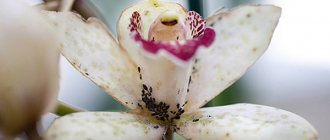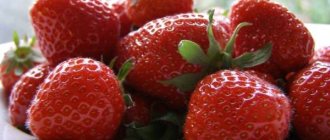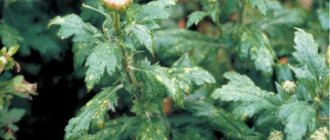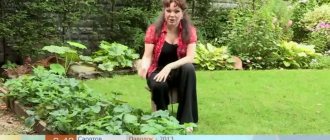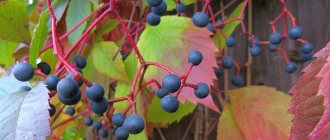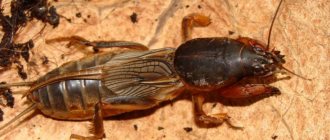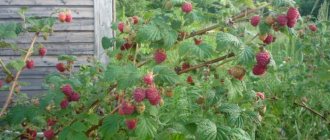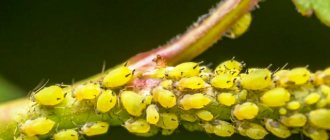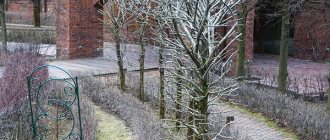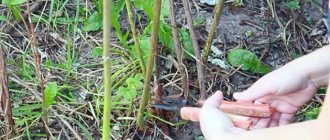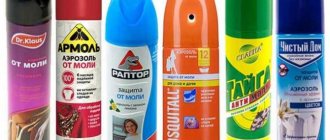The danger is the accumulation in one place of a colony of worms numbering 1000 individuals per 1 sq. m. It is not easy to detect the parasite - adult individuals are no more than 1-2 mm long.
Methods for controlling nematodes on strawberries
The nematode is a pest that is very difficult to control, so if not the entire bed is infected (and most often the nematode infection is focal), then it is better to remove the affected bushes, as well as all plants within a radius of 1 m.
The pest does not spread in the soil, so by removing the tendrils and the infected bushes themselves, there is a chance of saving the remaining plants.
Folk remedies
If the situation is not advanced or you simply don’t want to use chemicals, there is an alternative option than treating the berry plantation. Use folk remedies that are not so aggressive.
- Hot water
Since the nematode settles mainly on rhizomes and is afraid of elevated temperatures, it is recommended to spill the infected bed with hot water (no more than 55°C).
This method is used by many experienced gardeners and note its high efficiency. We dig up the affected strawberry bushes and wash their roots from the substrate under running water. Then we immerse them in a container of water, the temperature of which should be +47...55°C. Soak the rhizomes in water for 5-20 minutes.
The exposure time is determined by how badly the bushes are damaged. For example, to destroy only adult individuals, +40°C will be enough; eggs die at higher rates and over a long period of time - at +55°C for 20 minutes.
You should not make the water too hot, as you risk cooking the plant, which will eventually kill it!
- Flower infusions
The juice of some plants acts as a poison on roundworms. Based on them, you can prepare infusions and pour them over strawberries. Usually marigolds or marigolds are used. Take 1 kg of flowers, crush them, add 5 liters of warm water, infuse them covered in a warm place for 2 days and strain. Use every other day.
- Onion infusion
Soak 200 g of leeks in 5 liters of warm water for a day. Strain. Use for watering and irrigation once a week.
To prepare it, you should use a baton. Raw materials in the amount of 200 g are crushed and filled with five liters of water. Infected plants are watered with the prepared product every seven days.
- Ammonia
Rub a piece of laundry soap (72%), pour 1 liter of hot water into it, and beat thoroughly until a thick foam forms. Pour a bottle of 10% ammonia into another container with 1 liter of water at room temperature. Mix. Pour both resulting solutions into a bucket with 8 liters of water prepared in advance. After thoroughly mixing, without leaving for later, pour over the strawberries. Judging by the reviews, the product helps well against root nematodes.
- Infusion of marigolds
For the strawberry nematode, marigolds are a real poison. The aroma of these plants is very attractive to pests, but the juices of the flower are destructive to them. To prepare the product, 5 kg of raw materials must be filled with 5 liters of water and left for 48 hours in a warm place. We filter the finished infusion and water the infected plants.
- Infusion of calendula officinalis
Add 5 tablespoons of dried raw materials to half a bucket of water (5 l) and leave for at least a day at room temperature. To treat strawberry bushes, we use a ready-made watering agent once every seven days for a long time, to ensure prevention - a couple of times a month.
- Hogweed infusion
In order to prepare the drug, half a kilo of raw materials must be filled with five liters of water. After a day, we filter the infusion and spill the soil under the affected bushes.
Remember that hogweed is a poisonous plant, and therefore all manipulations with it, as well as with an infusion based on it, must be carried out with gloves and avoid contact of the product with the skin and mucous membranes!
- Nasturtium infusion
Pour 300 g of grass into five liters of water, leave for 24 hours, filter and use to water strawberries once a week.
Folk remedies are effective mainly in the early stages of infection or for preventive purposes.
Chemicals
Chemical preparations for strawberry nematodes are called nematicides. They are very aggressive and at the same time effective. When using them, you should be extremely careful:
- Follow the instructions and adhere to the dilution proportions of the solution.
- Spray the bushes either early in the morning or late in the evening, when there is no wind or heat.
- Wear a protective suit, gloves, mask, goggles, respirators, and appropriate shoes.
- Make sure in advance that there are no pets or children on the site at this time.
- It is necessary not only to spray the bushes, but also to thoroughly water the soil.
- Treatment regimen: at least 4 sprays with an interval of 5 days.
- The nematode quickly adapts to the drugs, so it is better to alternate them.
Nematicides include preparations based on methyl isothiocyanate. They can be sold in the form of a solution (Trapex) or a mixture (Di-Trapex). There are also fumigants (pesticides that act through the respiratory tract) that are used to completely sterilize the area. These are Dayfuran, Aldicarb (carbamate insecticide), Geophos, Dimpilat, Oksamil (carbamate, on the basis of which the nematicide Vidat is produced), Etoprop, Fenamiphos (characterized by increased fumigation activity), etc. These drugs are relatively safe for strawberries, but are highly toxic for people and animals, so they are most often used in breeding farms.
What chemicals are recommended for use on private farmland:
- Heterophos is a highly toxic pesticide, nematicide of contact, systemic and fumigation action;
- Lindane (Ruskamin) - destroys adult worms, but is not effective against cysts;
- Phosfamide is an organophosphate insecticide;
- Mercaptophos is a systemic poison.
Many people are afraid to use chemicals, as they have the ability to accumulate in plants and especially in berries, which are then eaten. And although manufacturers convince that the products do not pose any danger, not everyone trusts them. In this case, you can try using biological products developed based on natural substances. These include, for example, Fitoverm. This is a latest generation insectoacaricide that affects most garden pests. Available in the form of a concentrated emulsion or powder. Promises an effect already on the 7th day after spraying. However, judging by the reviews, it does not always work.
It is better to initially treat strawberries for nematodes with chemical and biological products, as they are the most effective.
After using chemicals, you cannot eat berries for several weeks (2-3)!
How to get rid of nematodes on strawberries
It is necessary to combat nematodes on strawberries in a comprehensive manner. What exactly will have to be done, in addition to chemical treatment:
- Remove the affected parts from the bush. If the entire bush has withered, remove it by the roots.
- Collect plant debris (fallen leaves and berries) from the garden bed.
- Pull out the weeds.
- Burn it all off site.
- Loosen the soil as deeply as possible.
- Pour hot water (55°C) and loosen again.
- Use a nematicide, and use a folk remedy in the intervals between its use.
- At the end of treatment, add complex fertilizer or rooting agent.
- In the fall, it is advisable to destroy a plantation that has suffered such a disease. Next year, choose a different place to plant strawberries.
Green manure
To avoid uprooting, the strawberry bed can be lined with marigolds around the perimeter. It is believed that the nematode cannot stand their smell.
Marigolds are not only planted between rows of strawberries, but are also used to prepare infusions against nematodes.
Strawberry nematode treatment plan
Having discovered signs of the disease, they begin the following set of measures:
| Timing of work | Characteristics of the measure |
| Spring | 1. An audit of the state of strawberry plantings is carried out weekly from spring to autumn. |
| in spring | 2. Application of organic, potassium-containing fertilizers, such as wood ash. |
Chemicals against nematodes
If you look closely, you can find light yellow grains on the roots.
This is a female nematode. It is no larger than a grain of sand. Substances from worm-like pests belong to the group of nematicides. The following drugs are popular:
- Mercaptophos;
- Lindan (otherwise, Ruskamin);
- Phosphamtide The listed products are used in the form of a 0.02% solution, the frequency of treatments is every 3 to 5 days.
- Heterophos 15 g is dissolved in 10 liters at a temperature of + 200. It is used not only for treating plantings, but also for soaking seedlings. Highly toxic! Work only in a respirator, rubber gloves, and thick clothing! Excavation work can be carried out after 45 days.
Prevention
In order to prevent the growth of the nematode population, it is first necessary to use clean and healthy planting material. Before purchasing, seedlings should be carefully examined, paying special attention to their root system. However, even without obvious signs of infection, it is advisable to spill the roots with hot water before planting them in the ground.
It is recommended to compost the soil on the site. And not only before planting seedlings, but throughout the entire growing season. Compost contains active forms of fungi that will help destroy the nematode.
Maintain crop rotation, changing the permanent location of the strawberries every 4-5 years. This measure will prevent the spread of pests throughout the garden. Fragrant varieties of marigolds are very attractive to nematodes and they crawl towards such plantings as if to a magnet. But since the juices of this plant are poisonous to parasites, after saturation they die. You can also plant calendula and nasturtium. Through their rhizomes, these plants secrete special substances that very successfully repel nematodes. In addition, along the perimeter of strawberry plantings, it is recommended to place herbaceous perennials such as drumonda, coreopsis, beautiful gaillardia and hairy rudbeckia.
Undesirable neighbors for strawberries are potatoes, tomatoes, celery, cabbage, carrots, peas and beans!
If the area has been infected and you have carried out work to destroy pests, then next year it is advisable to plant certain varieties of strawberries that are resistant to diseases and pests, including nematodes. These include:
- "Granddaughter";
- "Saxon"
- "Pearl";
- "Rocket";
- "Festival";
- "Dessert"
In spring and autumn, thoroughly clean the garden of weeds and plant debris, burning everything collected outside the site. This will allow the destruction of individuals that settled for the winter and were able to survive it.
When planting seedlings, try not to thicken the plantings. Care for them regularly, weed them and thin them from time to time. Thanks to these measures, you can significantly reduce the number of nematodes.
Description of the parasite with photo
Stem and leaf varieties of nematodes are dangerous for strawberry plantings. Parasites constantly live in the soil, but do not cause harm in small concentrations. The danger is the accumulation in one place of a colony of worms numbering 1000 individuals per 1 sq. m. It is not easy to detect the parasite - adult individuals are no more than 1-2 mm long.
Nematodes belong to the type of protostomes; the pest's mouthparts are in the form of forceps. Color white or yellow. Males and females differ in body shape. The female's body is round in shape because the uterus usually contains sperm. Nematodes are prolific; up to 2000 eggs can be found in one cyst.
The eggs are presented in the form of a microscopic capsule. After maturation, the larva hatches with a defective digestive and reproductive system and is smaller in body size than the adult.
Optimal development conditions are +18…+24ºС; at air temperatures above 40ºС the parasites die. Roundworms actively parasitize in acidic soils with a pH level of 5.5-5.8.
A nematode or Nematodes is a roundworm belonging to the phylum Protostomes. The body color is white, sometimes yellowish.
Males and females are easily distinguished by body shape. Females are rounder because they carry the eggs within themselves.
Causes of infection
The reasons may be climatic and agrotechnical:
- heat: when the air temperature stays above +18°C for a long time;
- high humidity: frequent rains and fogs;
- predominance of sand in the soil;
- too frequent watering;
- densely planted bushes;
- frequent phytopathologies that weaken the immunity of strawberries;
- nematode-infected planting material, garden tools, soil purchased or brought from another place.
The first task in the fight against the parasite is to determine the reasons for its appearance on the site. And if a person cannot influence climate factors, then he can improve agricultural technology.
Signs
If you detect the parasite on berry bushes in a timely manner, it will be easier to get rid of it. However, the problem is that these worms are very small and difficult to notice. Therefore, you should study in advance the question of what strawberry bushes look like when infected with a nematode. Main signs of infection:
- the leaves lose the fluff that usually covers their lower part;
- covered with swellings and galls;
- gather into an accordion and become rigid;
- the green color acquires an unhealthy saturation and shine;
- dark spots appear, limited by the location of the veins;
- petioles are shortened and curved;
- leaves, fruits, tendrils decrease in size;
- the central shoot becomes covered with swellings and gradually dies;
- cuttings turn red;
- the socket is deformed.
These are external signs of strawberry nematode infection, but most often they become noticeable when the health of the bushes is seriously damaged. You can confirm your fears in two more proven ways.
- Dig up one of the bushes and carefully examine the rhizome. If it is a nematode, it will be weak and covered in numerous small white eggs.
- Pick a few leaves, chop them, put them in a container with water and leave for a couple of hours. Small thread-like worms of white or yellowish color will float to the surface.
These parasites are so small that they are difficult to see with the naked eye, so it is better to use a magnifying glass.
What does the affected plant look like?
The nematode is extremely difficult to see with the naked eye. Its presence can be determined by indirect signs:
- Swelling on the stem or leaf veins;
- Shortening and curvature of petioles;
- Wrinkling and subsequent death of leaves;
- Deformation and reduction of the ovary;
- Specific swellings or galls form on the upper side of the leaves.
The growth of bushes slows down sharply, the plants seem to be “pressed” to the ground. Spreads through infected plants.
Reference! Infected seedlings can be identified upon inspection. In the earthen coma you can see white dots reminiscent of semolina. This is what female nematodes look like, filled with eggs.
Where does it come from and how is it distributed?
The nematode enters the site with planting material and as a result of non-compliance with crop rotation (predecessors of nightshades). Affected bushes appear in patches in the spring, then these patches unite and the entire bed dies. The nematode migrates weakly through the soil, mostly from bush to bush through the tendrils and other green parts of the plant.
How to distinguish a nematode from a strawberry mite
The signs of infection by mites and nematodes are similar: the leaves wrinkle and begin to shine, the bushes wither, the crops die, and the parasites themselves are not visible due to their microscopic size.
To differentiate the parasite you need to look through a magnifying glass. One is a thread-like worm, and the second is a round insect.
You will have to remove one of the bushes from the ground and carefully examine the root system. If it is strewn with numerous white eggs, it is a nematode.
Possible consequences of infection
If strawberries are affected by the strawberry nematode, the consequences can be dire. So, as a result of infection, plants and beds will wither. Therefore, appropriate measures should be taken in time so as not to lose the entire harvest.
In addition, worms are carriers of many phytopathogenic microorganisms, which can easily penetrate into crop tissue through affected areas eaten away by parasites. As a result, plants suffer from infections, diseases or loss of the entire crop.
Nematodes on the crop feed very actively and reproduce, in the process of which entire colonies are created. And due to the peculiarities of their development, standard pesticides do not have any toxic effect on them.
Affected fruits are dangerous for humans - allergies or the appearance of parasites in the intestines are possible.
A weakened crop becomes vulnerable to disease or infection. Also, the germination rate of crops decreases, the growth of crops becomes slow, and young bushes do not take root at all.
Strawberry varieties resistant to nematodes
There are no hybrids that are resistant only to nematodes. Breeders have developed many varieties of strawberries with powerful immunity to diseases and pests that resist, including nematodes. List of resistant varieties:
- Saxon,
- Festivalnaya,
- dessert,
- Rocket,
- Granddaughter,
- Pearl oyster.
If the site already has such a problem, it is worth paying special attention to prevention.
At the same time, they have strong immunity to viral and fungal infections.
The use of resistant varieties is the prevention of the most dangerous fungal diseases of garden strawberries.
The nematode is a pest that progresses over the years. Comprehensive preventive measures, timely watering, fertilizing and high-quality care of strawberry plantings will help prevent accumulations of worms that are dangerous to plants.
How dangerous is the pest?
Roundworms that attack strawberries live in the soil. They cause the greatest harm to plants when the root system is severely damaged. Nematodes damage leaves and stems. While sucking out the juice, they simultaneously inject toxins into the cells. The immune defense of infected specimens weakens. A viral infection often develops on such bushes.
Infection of strawberries occurs gradually. Usually the gardener notices the presence of the pest too late by visible signs and does not have time to apply all control methods. As a result, the root system dries out. Such plants bear fruit poorly and their frost resistance decreases. Therefore, most often, bushes affected by nematodes die in winter.
Questions and answers
“Epin – extra” is a unique growth stimulator that not only activates the development of the plant, but also increases immunity, which allows the plant to independently protect itself from diseases and pests, including nematodes.
Question No. 1. How long does it take to get rid of nematodes on strawberries?
Unfortunately, it is impossible to completely eliminate the nematode, but it is possible to reduce the number to a safe amount. Why does prevention and pest control need to be carried out constantly?
Question number 2 . Are nematodes dangerous for humans and pets?
No. The structure of the worms and nutritional needs are designed exclusively for plant juices.
Question number 3 . If strawberries are planted under agrofibre, will it protect against nematodes?
It will not be possible to completely get rid of the worm, but it will be possible to reduce the number and protect the strawberries. Spunbond creates conditions of high humidity that are uncomfortable for worms, which does not contribute to their spread.
Question number 4 . What drug is guaranteed to kill nematodes?
Unfortunately, such a tool has not yet been created. Substances that destroy worms belong to the group of nematicides. The difficulty is that most of them act on adults and damage the eggs. Those, in turn, can wait for favorable conditions for years. That is why it is necessary to carry out preventive measures and ensure that the number of pests does not increase.
Question number 5 . How to determine when purchasing whether there are nematodes on strawberries?
When purchasing seedlings, you need to carefully examine the roots and stems, especially those sold in pots with a lump. There should be no small whitish grains, similar to semolina, this is what females look like, filled with numerous eggs.
Symptoms of damage and reasons for the appearance of nematodes on strawberries
The difficulty of diagnosis lies in the fact that it is impossible to detect a microscopic worm at an early stage. Often external signs of damage resemble a lack of nutrients:
- Bush growth slows down;
- The ovary and fruits are deformed;
- The leaves noticeably become smaller and curl up, and swellings—galls—appear on the upper surface;
- The petioles thicken and shorten.
External signs of the disease appear during flowering and fruiting. In this case, the pest cannot be detected.
You can see the nematode under a microscope; the worm is transparent. Detecting a nematode is very difficult. It not only sticks to the plant, but damages the tissue and causes infection. Most often these are pathogens of fungal diseases. This way the pest infects the strawberries.
Nematodes are present in any soil, but they are dangerous when they are concentrated in one place. This is precisely what can explain the defeat of just a few strawberry bushes, which creates bald spots in the plantings. Complete drying out is rare when the number of nematodes exceeds 1 thousand pieces per 1 square meter. cm.
Worm eggs can remain viable for many years, and under favorable conditions become more active. Particularly intensive growth is observed on moderately moist, acidic soils pH – 5.5 – 5.8, at temperatures + 24 – + 30. Most often, nematodes appear together with infected seedlings.
When purchasing strawberry seedlings, it is important not only to evaluate the appearance of the bush, but also to carefully examine the roots.
Even if no external signs of damage are found, before planting you need to take measures against the spread of the pest. Carefully inspect the roots. There should be no suspicious spots or inclusions on them. For prevention, pour hot water over the roots.
What are the signs to identify a nematode?
The main signs of the nematode are depressed, squat plants and stunted growth. Leaves, peduncles, petioles, deformed mustaches,
- The leaves wrinkle, curl, may become smaller, become leathery (rough and similar to corrugated paper), and look as if they are pulled towards the central vein. The central vein of the leaf has swelling, it seems that the leaf is broken in several places.
- The petioles are shortened, thick, twisted, acquire an atypical reddish color, and the pubescence disappears.
- Stems thicken and branch heavily
- The buds, flowers and ovaries take on an ugly shape, sometimes forming like a miniature green head of cauliflower.
- Pale green growths form on the mustache, the mustache is thickened and shortened.
- Berries become small and ugly
- The tissues of leaves, petioles, peduncles and tendrils become loose.
The signs of mite and nematode infestation are very similar. The main difference: with a nematode, dark green leathery spots appear on the leaf, and with a mite, the leaf becomes lighter.
Signs of strawberry nematode infection and damage caused
The appearance of strawberry leaf nematode can be determined by the following signs:
- growth slows down, the plant gradually becomes dwarf in size;
- change in color of leaves and stems - at the initial stage they turn yellow, then turn black;
- the veins of the leaves thicken and acquire a yellowish color;
- the appearance of spots of different colors from pale green to dark brown;
- leaf petioles become red;
- gradual death of the central part of the bush;
- deformation of rosettes, shortening of mustaches;
- damage to rhizomes;
- poor flowering or lack thereof, shredding of peduncles;
- small berry sizes.
Ultimately, nematode disease leads to a decrease in yield. The plant becomes susceptible to various bacteria, fungi, and pests. In case of severe infestation, the plantation must be removed.
Often the parasite is localized in certain areas and selects single bushes or, on the contrary, densely planted areas.
The strawberry nematode affects not only strawberry bushes, but lilies, chrysanthemums, hellebore, lily of the valley, sage, violet, narcissus, anemone, cyclamen, and peony.
The main reason for the appearance of nematodes on the site is the acquisition of infected seedlings or soil. Parasites can also be carried on instruments. The greatest peak of pest development is observed in damp, humid weather at the beginning of summer at moderate temperatures.
Mistakes when dealing with pests
When eliminating roundworms, gardeners often make mistakes:
- They fight nematodes with insecticides. Chemicals from this group are intended to kill harmful insects.
- Throw the affected bushes into a compost pit - the pest eggs will successfully survive the winter and, after applying biological fertilizer, will progress throughout the entire area.
- Ignores infected bushes. If 1-2 bushes wither, the seedlings must be removed to avoid damage to all strawberry plantings.
Previous
Strawberries and strawberries How to treat strawberries against weevils - safe means for control and prevention
Next
Strawberries and strawberriesThrips on strawberries: signs of infection and control methods
Folk methods of struggle, scientifically proven
Planting strawberries under black agrofibre
Experienced gardeners save nematode-affected strawberries by treating them in hot water. Recommendations for processing:
- Dig up a bush.
- Thoroughly wash the roots from the soil. Used water should not be used for irrigation or composting.
- The roots are placed in water with a temperature of + 470 - + 550, it cannot be hotter, otherwise the plant can be boiled.
- There is debate about the processing time, some advise 5 minutes, others argue that at least twenty are needed. Adults die at + 400; to destroy eggs, the temperature must be higher and the time in water longer. Hot water does not harm the plant, but the pest dies.
Scientists confirm the effectiveness of the method. They explain that the optimal temperature for the development of nematodes is + 180 - + 240; at + 40 or more, the strawberry nematode dies. “Water procedures” are carried out on strawberries with obvious signs of damage. Suspicious bushes with mild symptoms can be treated with herbal decoctions and infusions, without digging.
